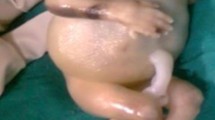Abstract
Aim of the study
To determine the impact of maternal age, consanguinity, season of conception and variation in the amount of amniotic fluid for the appearance of anomalies associated with neural tube defects (NTDs).
Materials and methods
150 NTD fetuses, a result from autopsies (macroscopic autopsy; microscopic study of biopsy fragments; macro and microscopic brain examination), have been examined during a period of three years (01.2006, 01.2009), in the Clinic of Fetopathology, at the Center of Maternity and Neonatology — Tunisia.
Results
Anomalies associated with NTDs occur three times more often in pregnancies with an abnormal amount of amniotic fluid. Also, their likelihood of cardiovascular and reproductive system anomalies is increased four times. Nearly 80% of the NTD fetuses conceived during the autumn-winter period have acrania. Women older than 35, are twice more likely to have underweight children and children with defects of the digestive system and hand. They are also three times more likely to have fetuses with endocrine system abnormalities. Anomalies incompatible with life occur twice as often in consanguineous unions.
Conclusion
The mother’s age, consanguinity, season of conception, and variation in the amount of amniotic fluid have considerable impact on the emergence of associated anomalies in fetuses with NTDs.
Similar content being viewed by others
References
Dolk H., Loane M., Garne E. The prevalence of congenital anomalies in Europe. Adv Exp Med Biol, 2010, 686, 349–364
Henk J. Folic acid, methylation and neural tube closure in humans. Birth Defects Res., 2009, 85, 295–302
Lindenbaum J., Savage D.G., Stabler S.P., Allen R.H. Diagnosis of cobalamin deficiency: relative sensitivities of serum cobalamin. Methylmalonic acid and total homocysteine concentrations. Am J Hem., 1990, 34, 99–107
Seyit C.T., Beyan C., Atay V., Yaman H., Alanbay I., Kaptan A. Serum vitamin B12 and homocysteine levels in pregnant women with neural tube defect. Gynecological Endocrinology, 2010, 26, 578–581
Stonek F., Hafner E., Philipp K., Hefler L.A., Bentz E.K., Tempfer C.B. Methylenetetrahydrofolate reductase C677T polymorphism and pregnancy complications. Obstet Gynecol., 2007, 110, 363–368
Koch M.C., Stegmann K., Ziegler A., Schröter B., Ermert A. Evaluation of the MTHFR C677T allele and the MTHFR gene locus in a German spina bifida population. Eur J Pediatr., 1998, 157, 487–492
Mornet E., Muller F., Lenvoisé-Furet A., Delezoide A.L., Col J.Y., Simon-Bouy B. Screening of the C677T mutation on the methylenetetrahydrofolate reductase gene in French patients with neural tube defects. Hum Genet, 1997, 100, 512–514
Weitkamp L.R., Tackels D.C., Hunter A.G., Holmes L.B., Schwartz C.E. Heterozygote advantage of the MTHFR gene in patients with neural-tube defect and their relatives. Lancet, 1998, 1554–1555
Martínez-Villarreal L.E., Delgado-Enciso I., Valdéz-Leal R., Ortíz-López R., Rojas-Martínez A., Limón-Benavides C. Folate levels and N(5), N(10) — methylenetetrahydrofolate reductase genotype (MTHFR) in mothers of offspring with neural tube defects: a casecontrol study. Arch Med Res., 2001, 32, 277–282
Al-Gazali L.I, Padmanabhan R., Melnyk S., Yi P., Pogribny I.P., Pogribna M. Abnormal folate metabolism and genetic polymorphism of the folate path way in a child with Down syndrome and neural tube defect. Am J Med Genet, 2001, 103, 128–132
Doğan H., Sahinoglu S. Fetuses with neural tube defects: ethical approaches and the role of health care professionals in Turkish health care institutions. Nurs Ethics., 2005, 12, 59–78
Onrat S.T., Seyman H., Konuk M. Incidence of neural tube defects in Afyonkarahisar, Western Turkey. Genet Mol Res., 2009, 8, 154–156
Golalipour M.J., Mobasheri E., Vakili M.A., Keshtkar A.A. Epidemiology of neural tube defects in northern Iran, 1998–2003. East Mediterr Health J., 2007, 13, 560–566
Golalipour M.J, Najafi L., Keshtkar AA. Neural Tube Defects in Native Fars Ethnicity in Northern Iran. Iranian Journal Of Public Health, 2010, 3, 116–123
Afshar M., Golalipour M.J., Farhud D. Epidemiologic aspects of neural tube defects in South East Iran Neurosciences, 2006, 11, 289–292
Behrooz A. Prevalence of neural tube defect and its relative factors in south-west of Iran. Pakistan Journal Of Medical Sciences, 2007, 23, 654–656
Al-Ani Z.R., Al-Hiali S.J., Al-Mehimdi S.M. Neural tube defects among neonates delivered in Al-Ramadi Maternity and Children’s Hospital, western Iraq. Saudi Med J., 2010, 31, 163–169
Houcher B., Bourouba R., Djabi F., Houcher Z. The prevalence of neural tube defects in Setif University Maternity Hospital, Algeria-3 years review (2004–2006). Pteridines, 2008, 19, 12–18
De la Vega A., López-Cepero R. Seasonal variations in the incidence of some congenital anomalies in Puerto Rico based on the timing of conception. P R Health Sci J., 2009, 28, 121–125
Siffel C., Alverson C.J., Correa A. Analysis of seasonal variation of birth defects in Atlanta. Birth Defects Res A Clin Mol Teratol., 2005,73,655–662
Perveen F., Tyyab S. Frequency and pattern of distribution of congenital anomalies in the newborn and associated maternal risk factors. J Coll Physicians Surg Pak., 2007, 17, 340–343
Sreenivas T., Nataraj A.R. Parental consanguinity and associated factors in congenital talipes equinovarus. Foot, 2012, 1, 2–5
Abd E., Ghani A., El Ansarry K. Neural Tube Defects. Asjog., 2006, 3. Available from: URL: http://www.asjog.org Accessed November 12, 2010
Dias M.S., Partington M. Embryology of myelomeningocele and anencephaly. Neurosurg Focus, 2004,16, E1
Author information
Authors and Affiliations
Corresponding author
About this article
Cite this article
Kitova, T.T., Karaslavova, E.G., Masmoudi, A. et al. Maternal factors and associated anomalies in NTD fetuses from Tunisia. cent.eur.j.med 8, 707–712 (2013). https://doi.org/10.2478/s11536-013-0238-6
Received:
Accepted:
Published:
Issue Date:
DOI: https://doi.org/10.2478/s11536-013-0238-6




